Abstract
Certain former operations in capacitor manufacturing resulted in extensive direct contact of the workers with electrical grade polychlorinated biphenyls (PCBs). A study group of 194 such individuals, all exposed to Aroclor 1016 and many previously exposed to Aroclors 1242 and/or 1254, was examined before (1976) and after (1979) discontinuance of PCB use in the operations (1977). At the two examinations, the approximate geometric mean serum levels (in ppb) and 5 to 95% ranges were for lower PCBs (LPCB), 363 (57-2270) and 68 (12-392); and for higher PCBs (HPCB), 30 (6-142) and 19 (4-108), respectively. The statistical associations among 42 measured clinical chemical and hematological parameters, five different measures of PCB exposure, and seven confounding variables observed in the two examinations were determined by three regression procedures. Similar regressions were performed with DDE, which was present at background levels. The principal statistical findings were a depression in serum bilirubin and elevations in serum GGTP and lymphocyte levels at the time of the first examination, and only an elevation in monocytes at the second. Appraisal of the results suggested an induction of microsomal enzymes which appeared to be subsiding after the cessation of direct exposure to PCBs. The statistical association between serum levels of PCBs and lipids reported by others was confirmed, but shown to be explained by the partitioning behavior of PCB in the body, rather than to changes in liver function. No evidence for health impairment related to PCBs was found, despite the high serum levels of PCBs in the study population.
Full text
PDF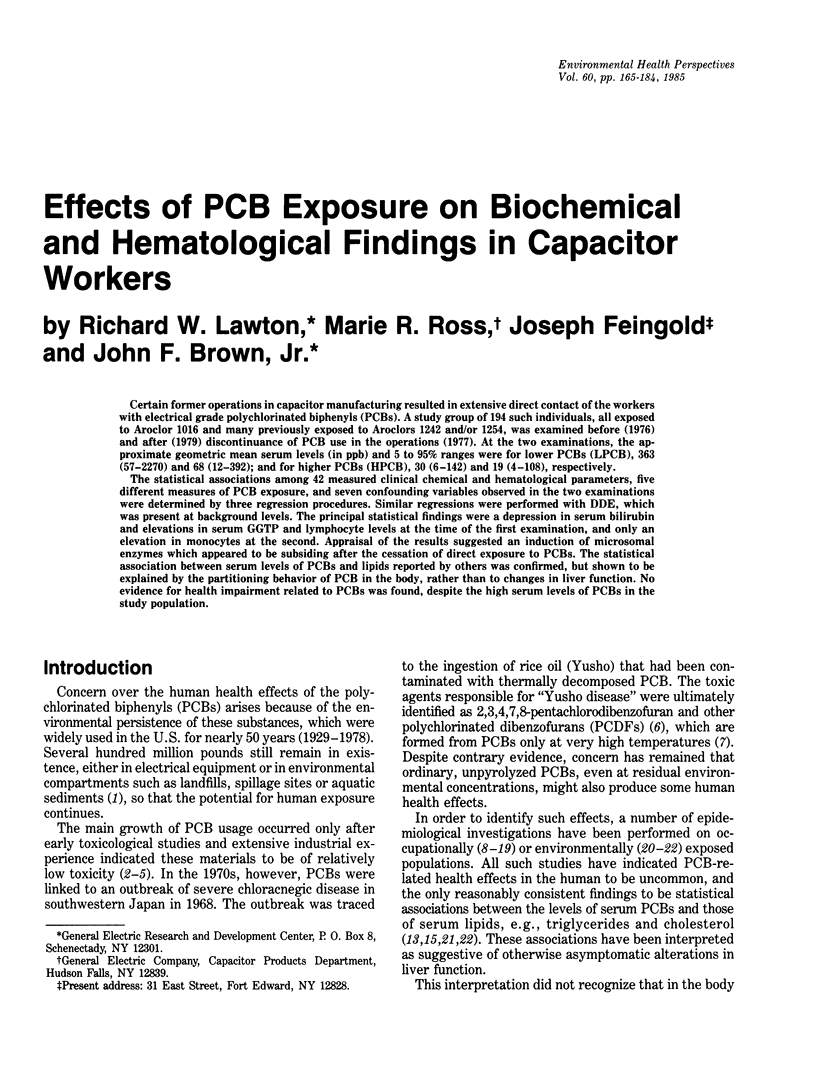

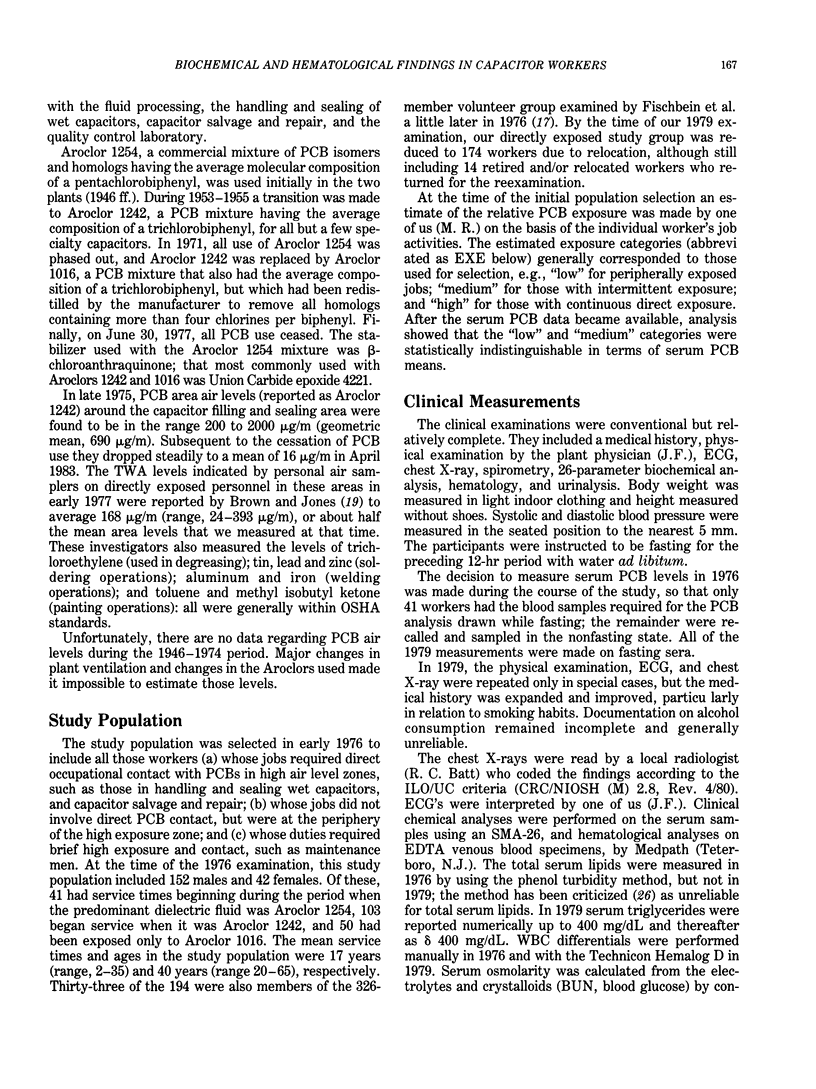
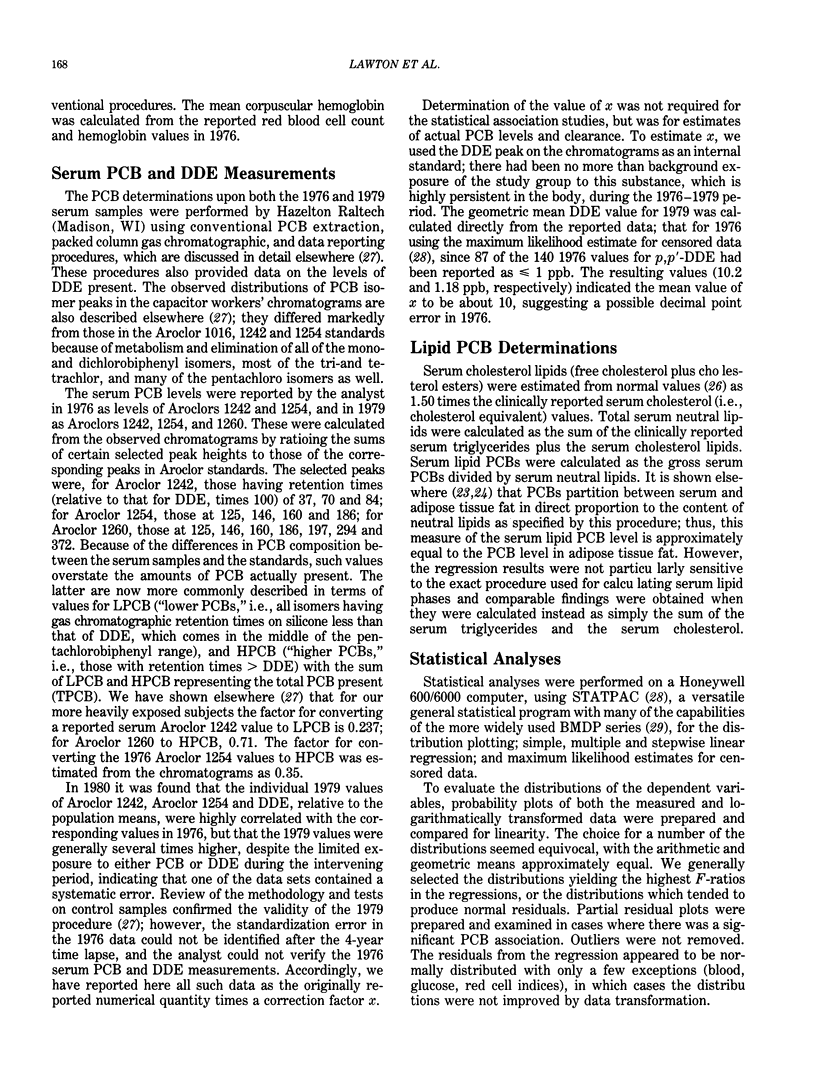

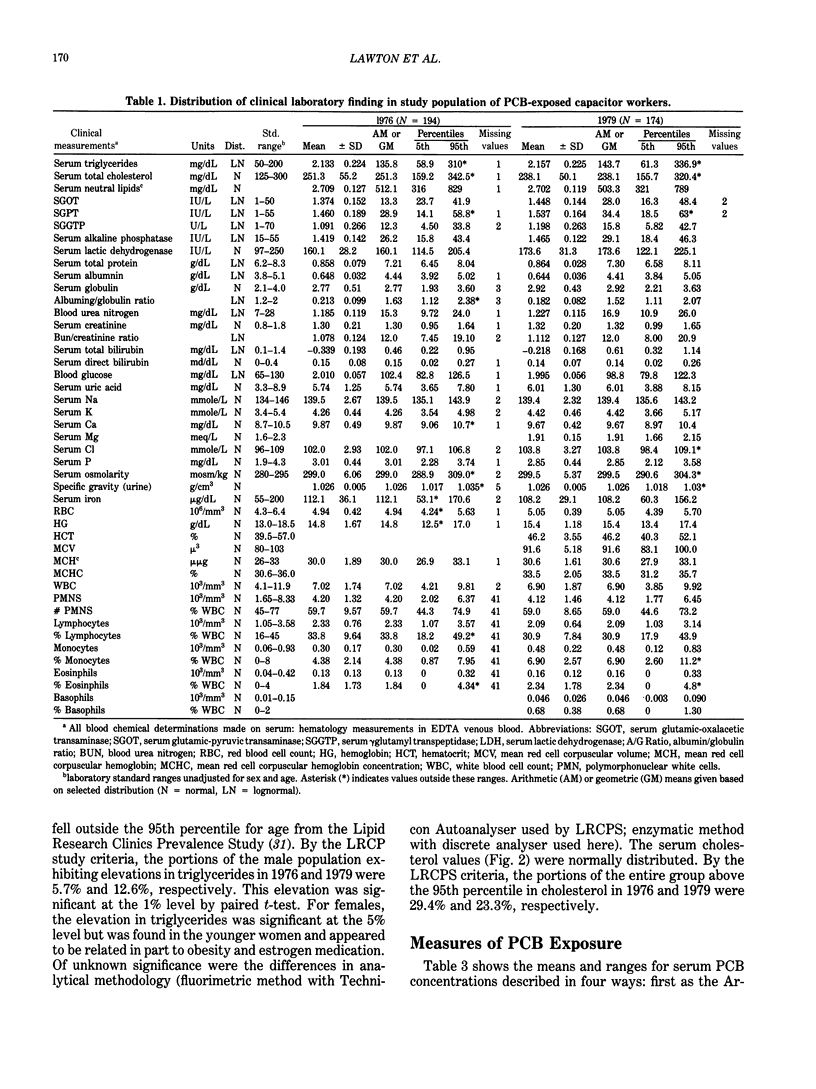
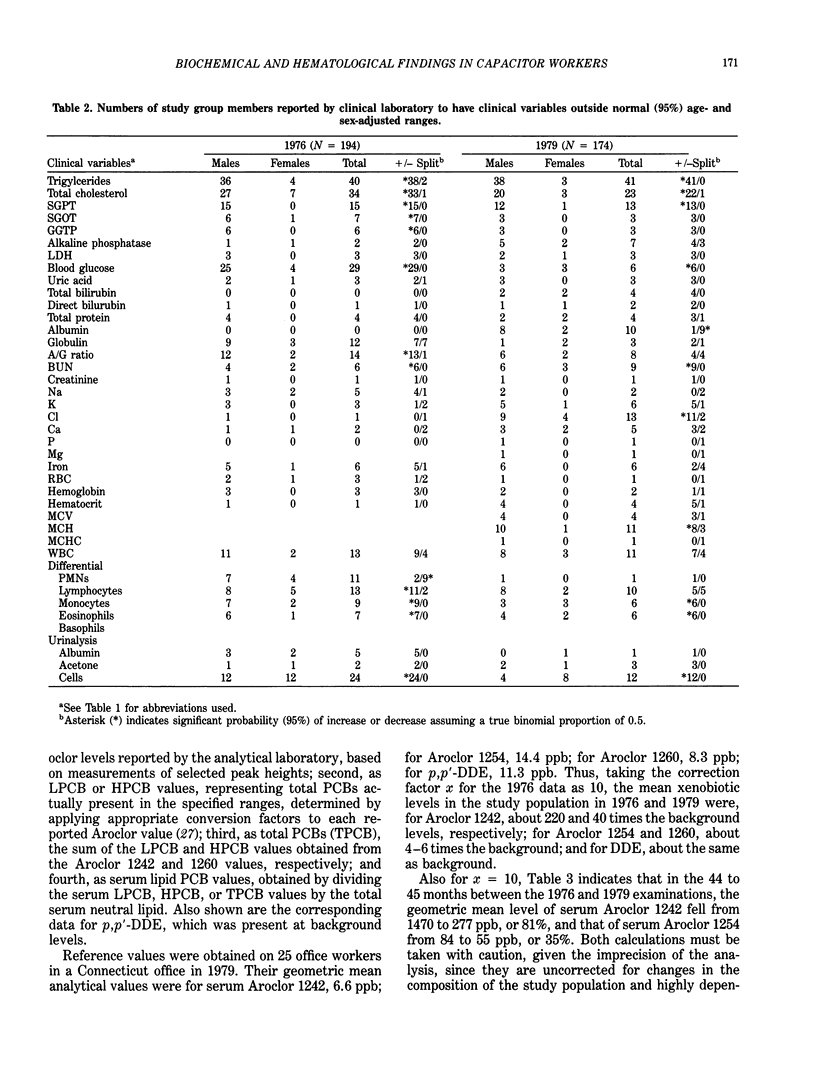
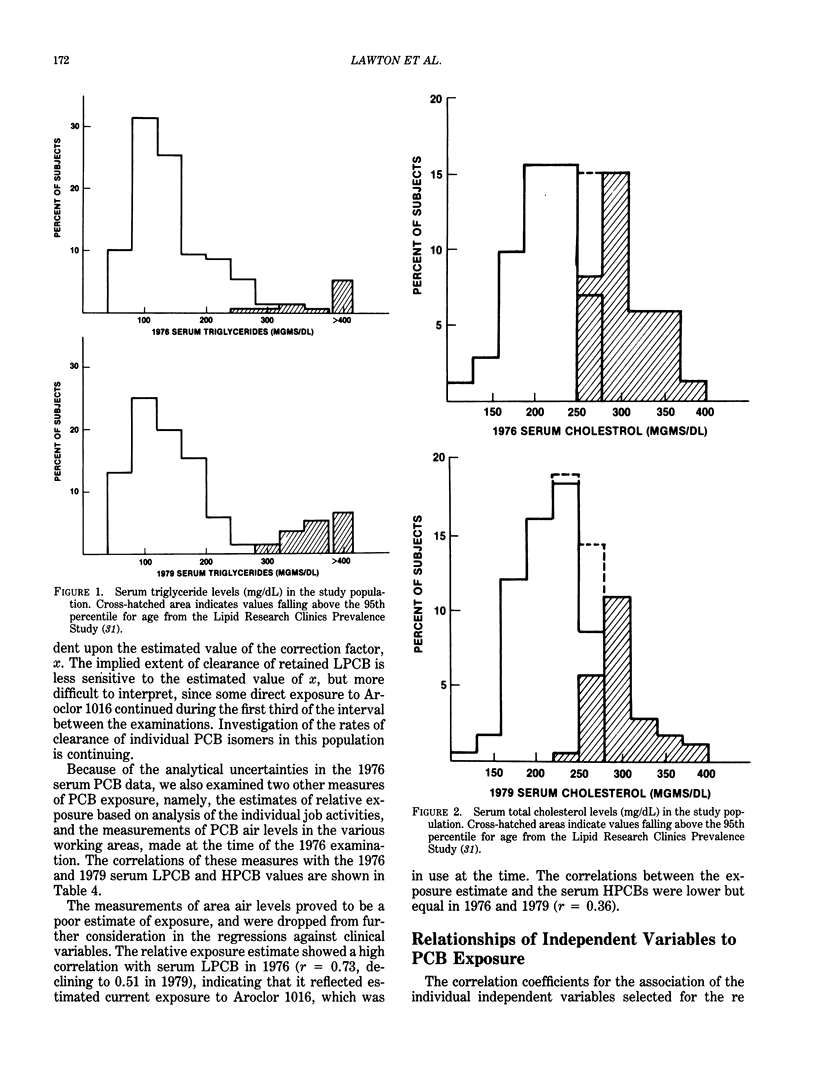
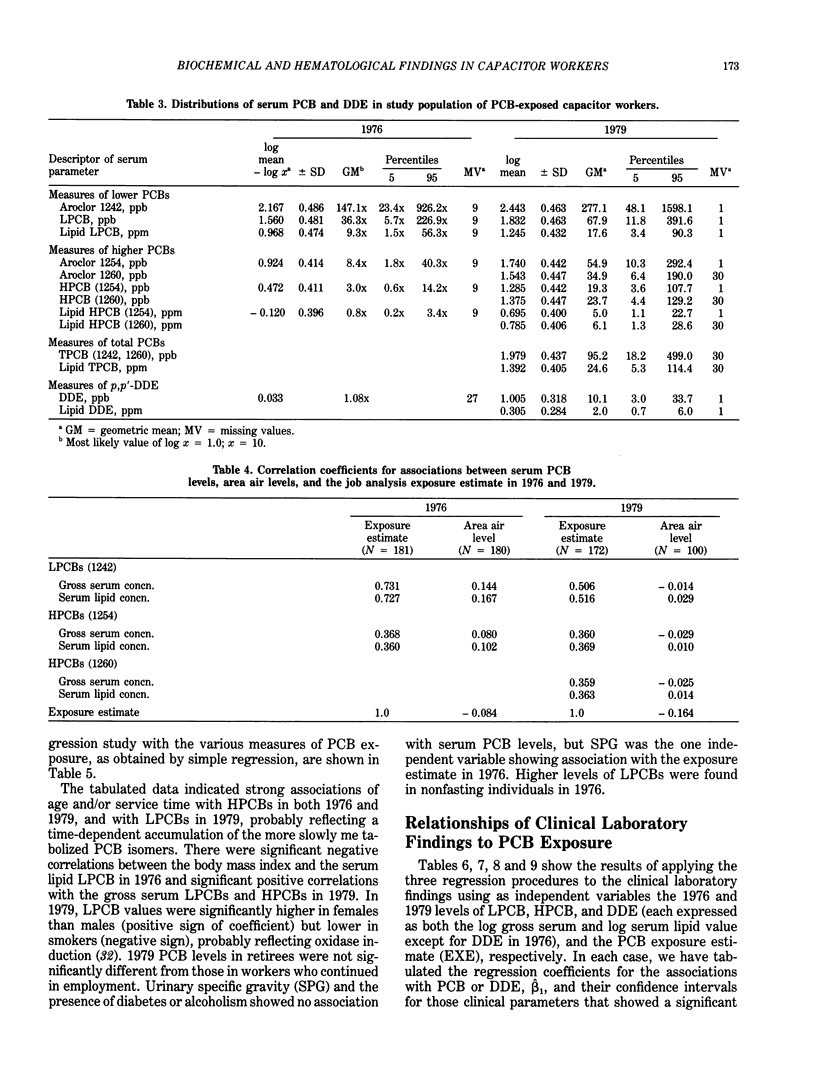
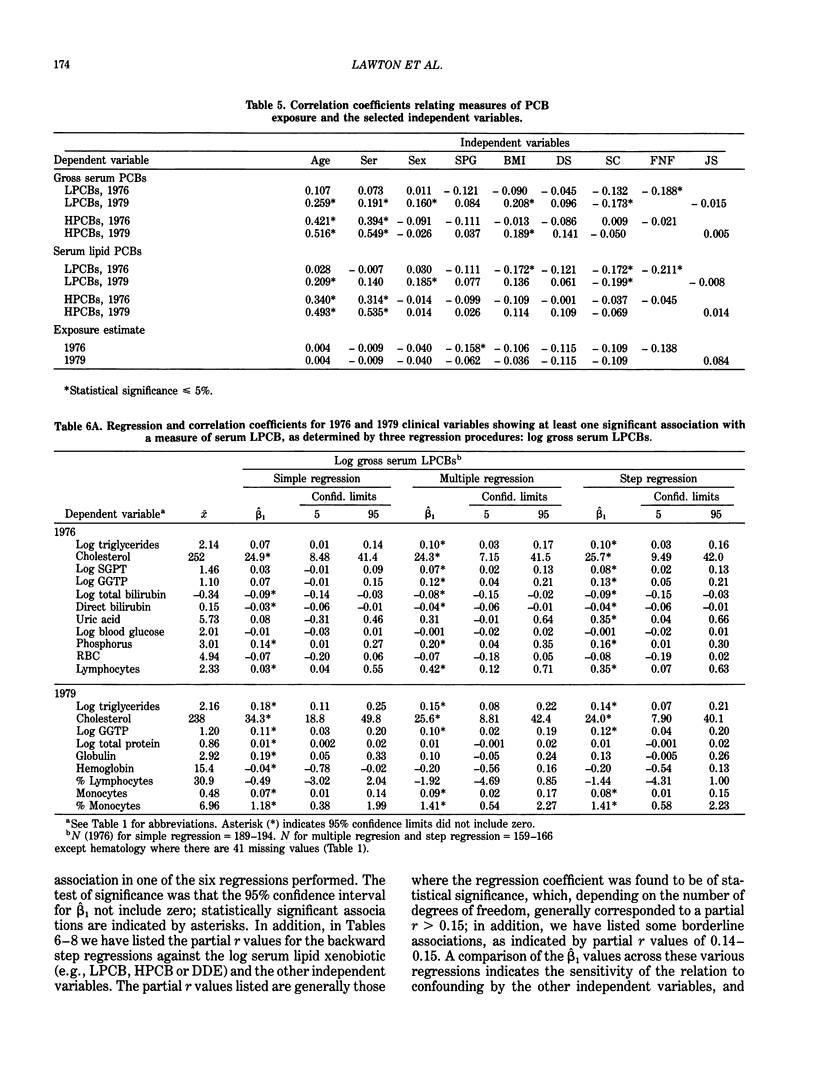
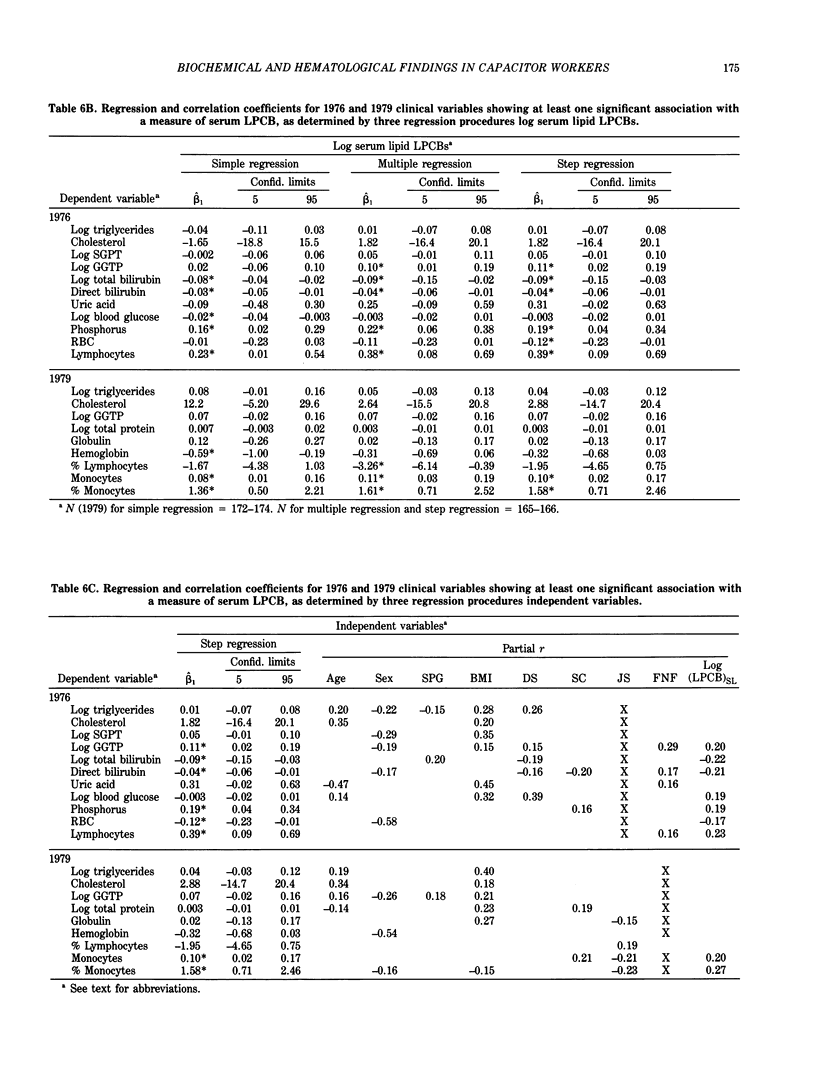
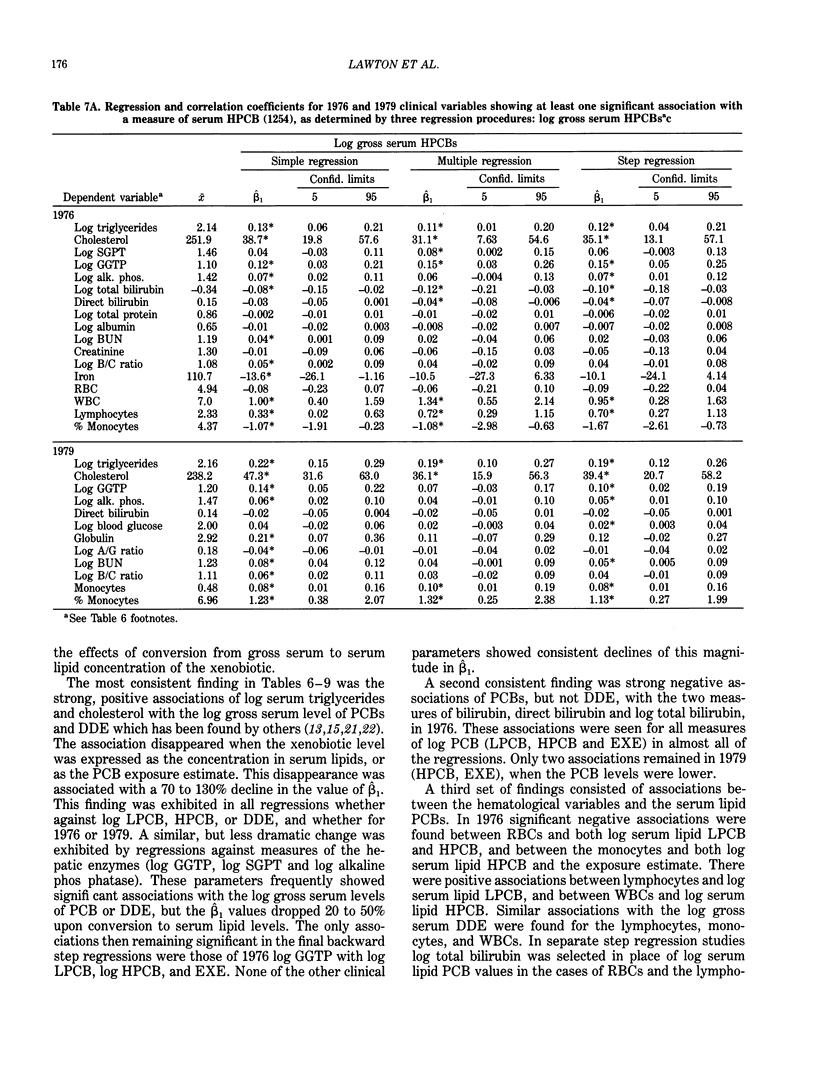

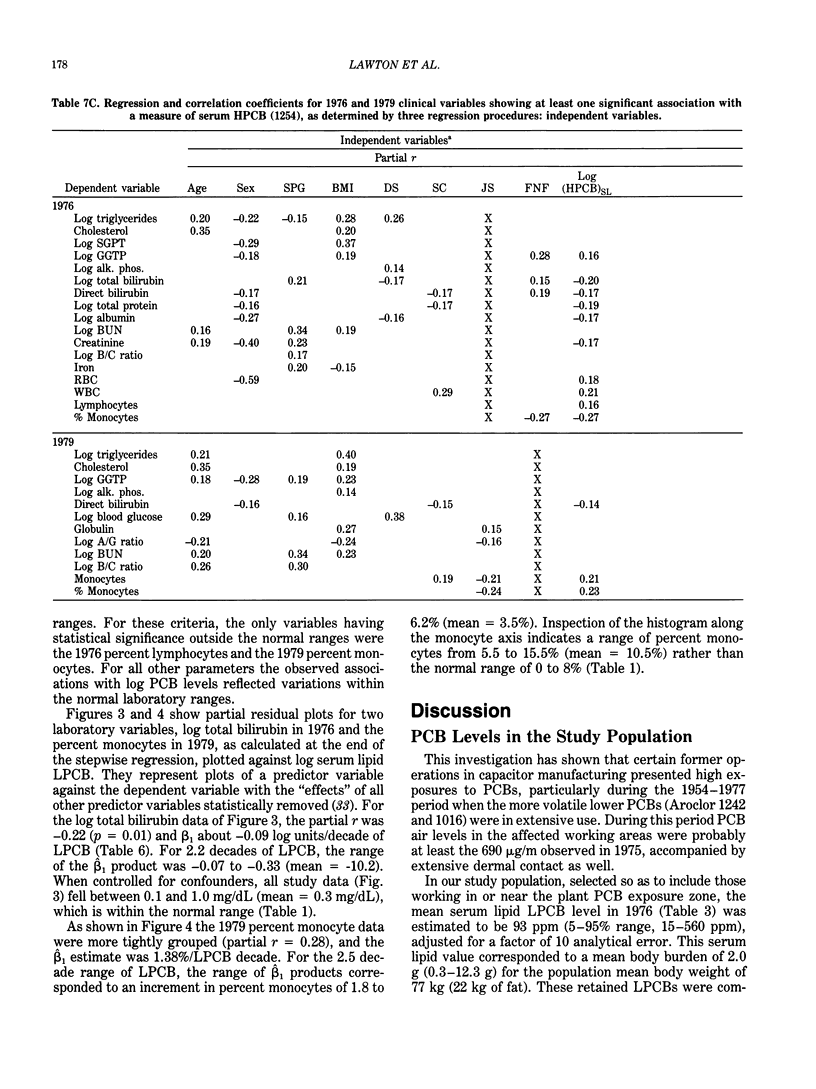
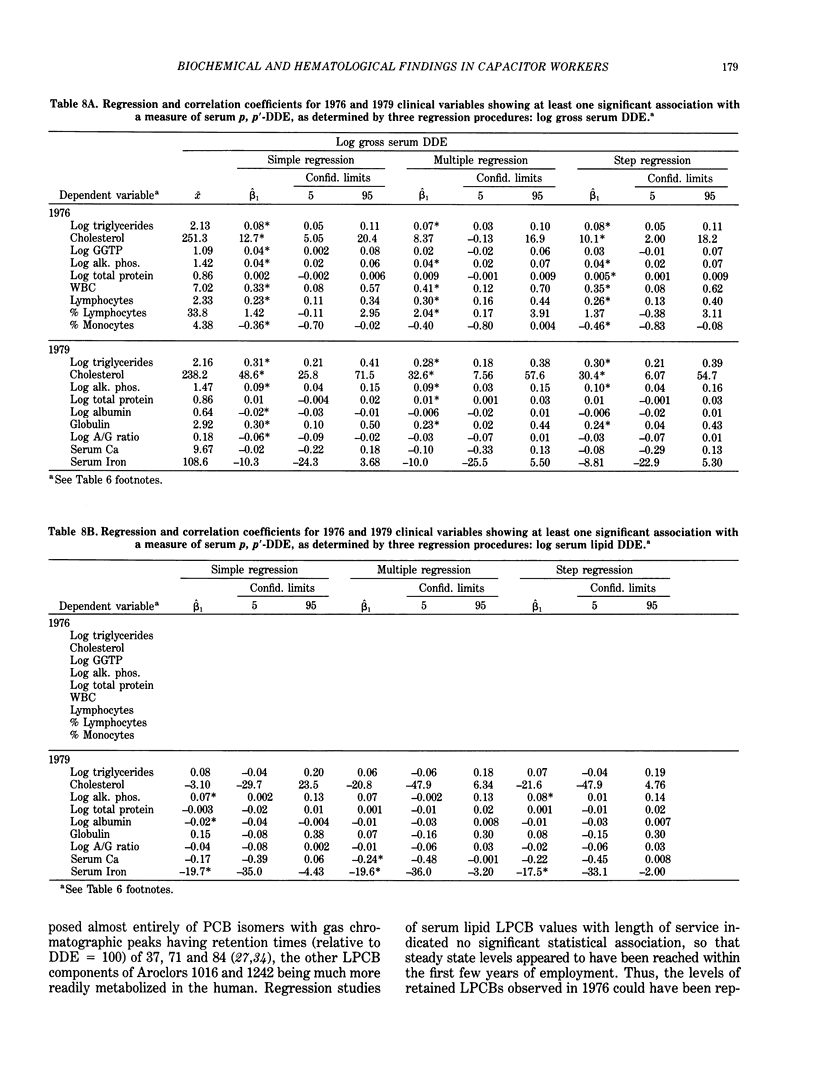
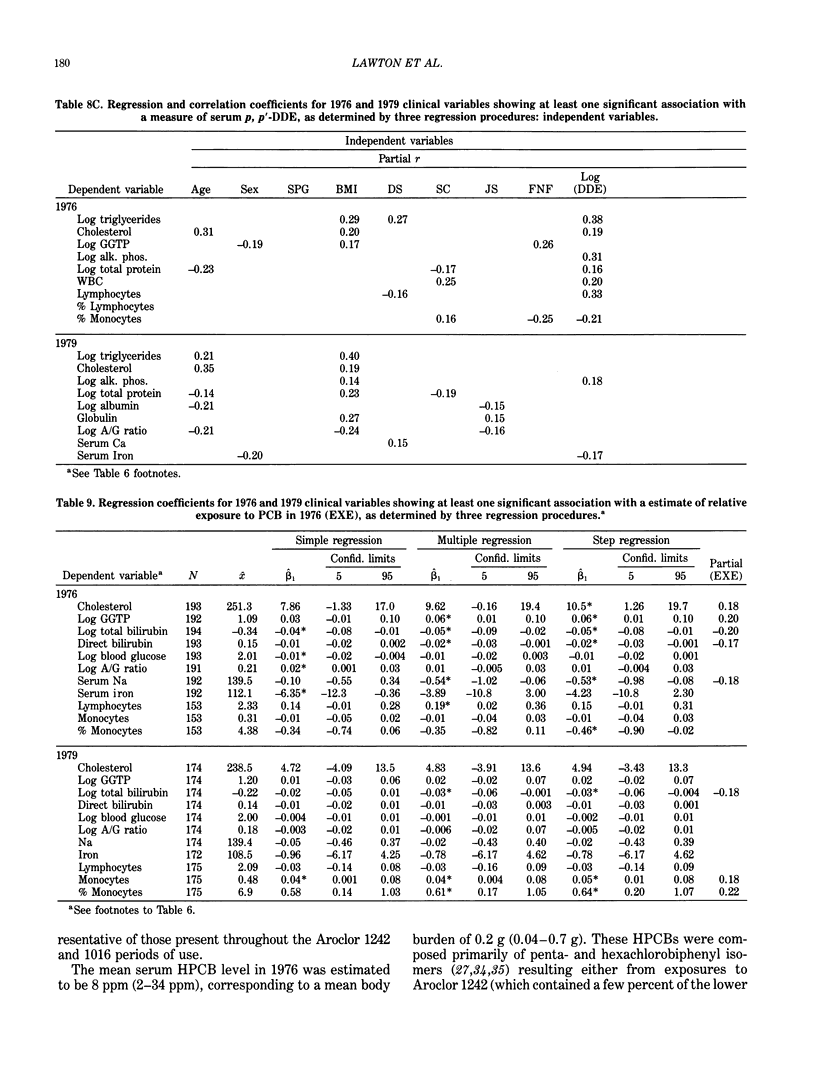

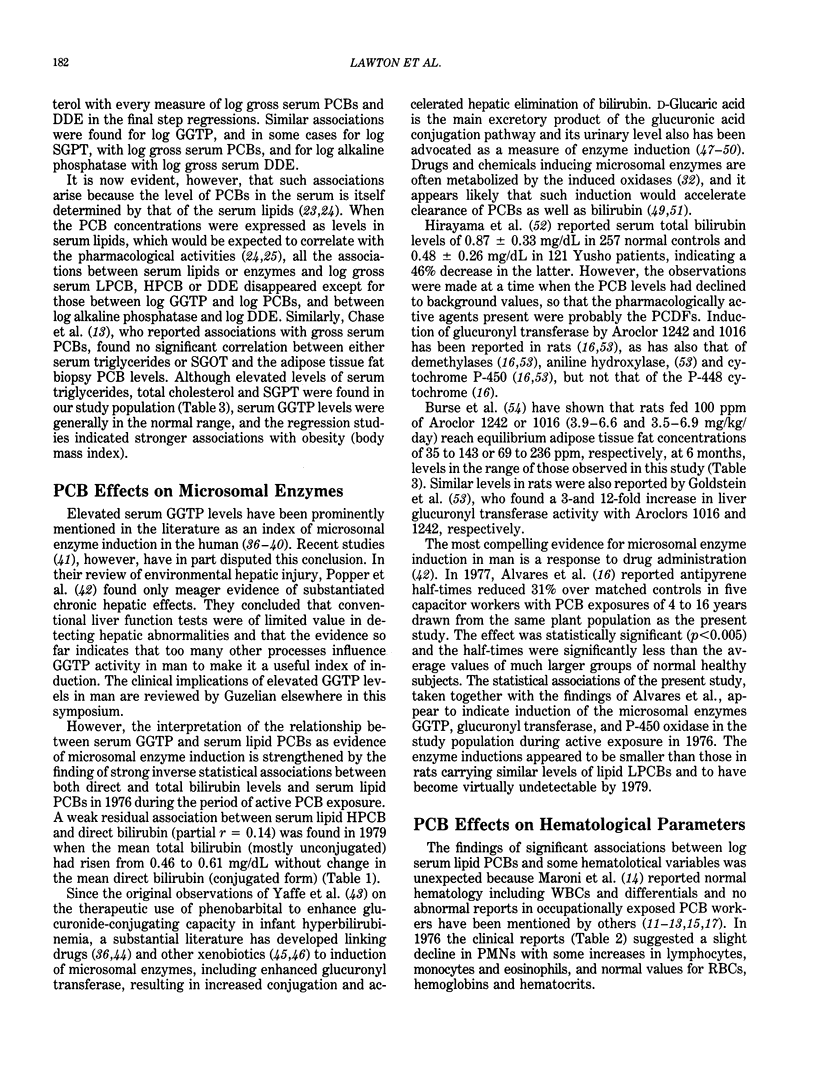
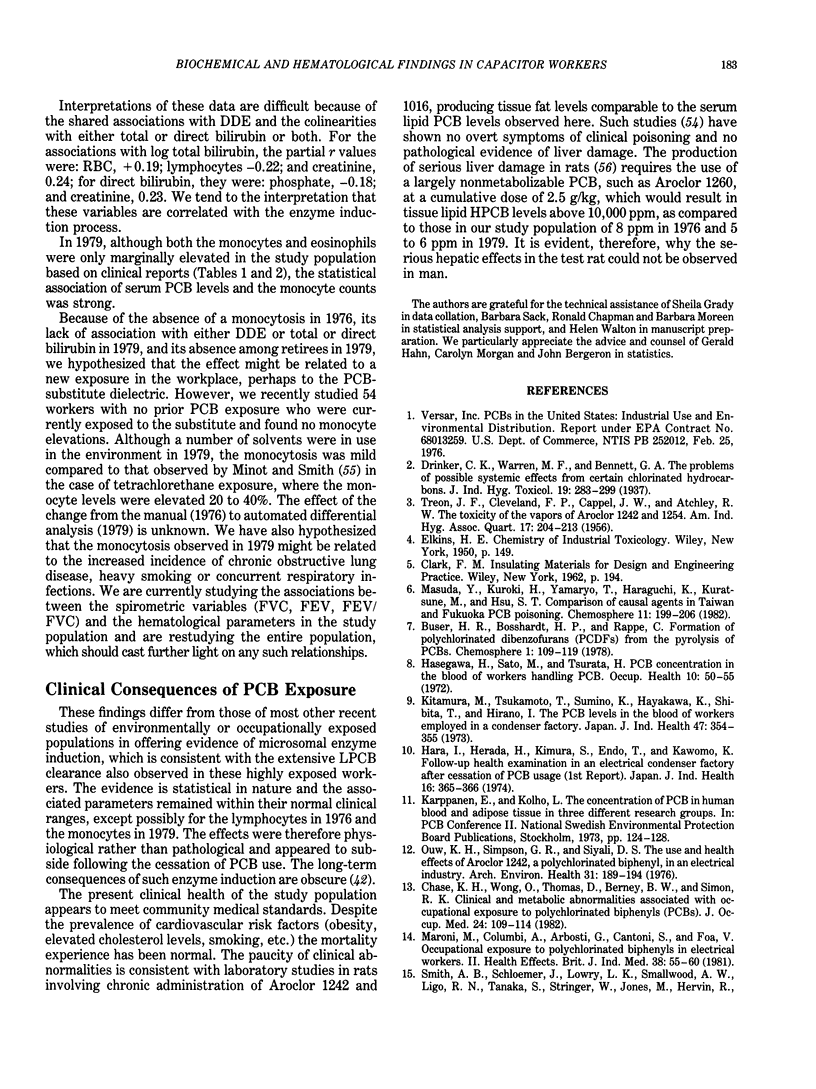
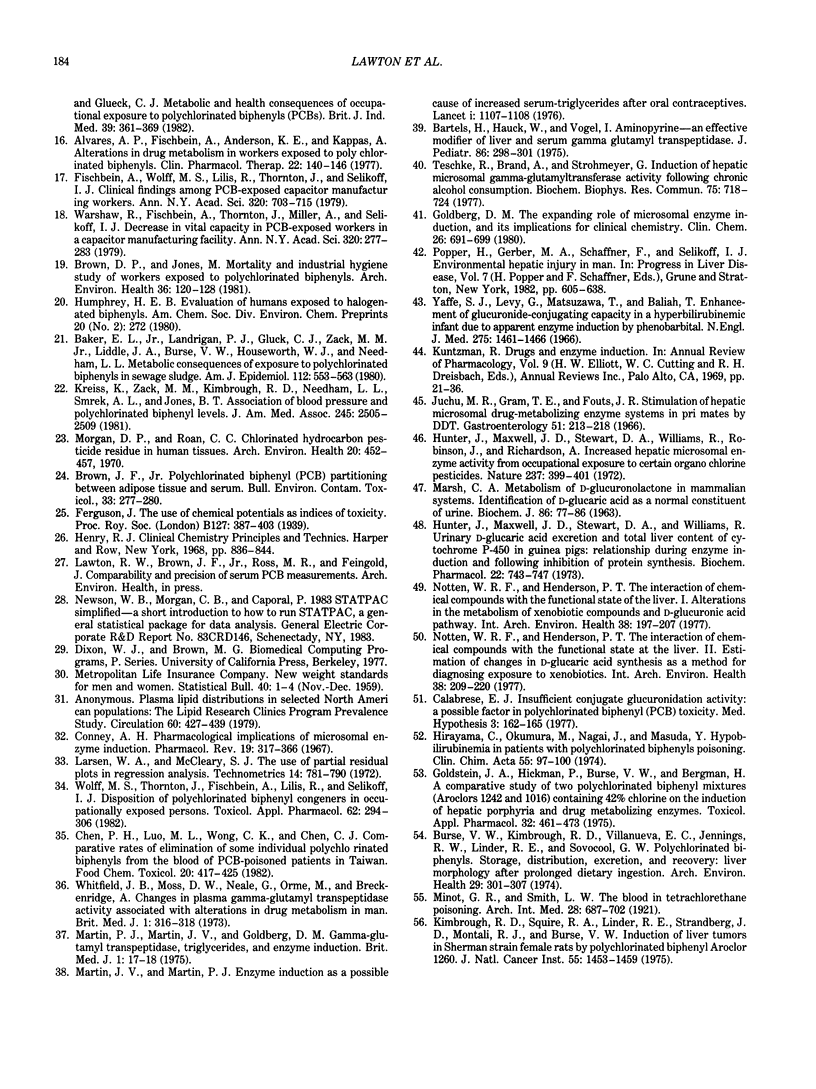
Selected References
These references are in PubMed. This may not be the complete list of references from this article.
- Alvares A. P., Fischbein A., Anderson K. E., Kappas A. Alterations in drug metabolism in workers exposed to polychlorinated biphenyls. Clin Pharmacol Ther. 1977 Aug;22(2):140–146. doi: 10.1002/cpt1977222140. [DOI] [PubMed] [Google Scholar]
- Baker E. L., Jr, Landrigan P. J., Glueck C. J., Zack M. M., Jr, Liddle J. A., Burse V. W., Housworth W. J., Needham L. L. Metabolic consequences of exposure to polychlorinated biphenyls (PCB) in sewage sludge. Am J Epidemiol. 1980 Oct;112(4):553–563. doi: 10.1093/oxfordjournals.aje.a113024. [DOI] [PubMed] [Google Scholar]
- Bartels H., Hauck W., Vogel I. Aminopyrine--an effective modifier of liver and serum gamma glutamyl transpeptidase. J Pediatr. 1975 Feb;86(2):298–301. doi: 10.1016/s0022-3476(75)80494-x. [DOI] [PubMed] [Google Scholar]
- Brown D. P., Jones M. Mortality and industrial hygiene study of workers exposed to polychlorinated biphenyls. Arch Environ Health. 1981 May-Jun;36(3):120–129. doi: 10.1080/00039896.1981.10667615. [DOI] [PubMed] [Google Scholar]
- Brown J. F., Jr, Lawton R. W. Polychlorinated biphenyl (PCB) partitioning between adipose tissue and serum. Bull Environ Contam Toxicol. 1984 Sep;33(3):277–280. doi: 10.1007/BF01625543. [DOI] [PubMed] [Google Scholar]
- Burse V. W., Kimbrough R. D., Villanueva E. C., Jennings R. W., Linder R. E., Sovocool G. W. Polychlorinated biphenyls. Storage, distribution, excretion, and recovery: liver morphology after prolonged dietary ingestion. Arch Environ Health. 1974 Dec;29(6):301–307. doi: 10.1080/00039896.1974.10666603. [DOI] [PubMed] [Google Scholar]
- Calabrese E. J. Insufficient conjugate glucuronidation activity: a possible factor in polychlorinated biphenyl (PCB) toxicity. Med Hypotheses. 1977 Jul-Aug;3(4):162–165. doi: 10.1016/0306-9877(77)90067-6. [DOI] [PubMed] [Google Scholar]
- Chase K. H., Wong O., Thomas D., Berney B. W., Simon R. K. Clinical and metabolic abnormalities associated with occupational exposure to polychlorinated biphenyls (PCBs). J Occup Med. 1982 Feb;24(2):109–114. [PubMed] [Google Scholar]
- Chen P. H., Luo M. L., Wong C. K., Chen C. J. Comparative rates of elimination of some individual polychlorinated biphenyls from the blood of PCB-poisoned patients in Taiwan. Food Chem Toxicol. 1982 Aug;20(4):417–425. doi: 10.1016/s0278-6915(82)80107-5. [DOI] [PubMed] [Google Scholar]
- Conney A. H. Pharmacological implications of microsomal enzyme induction. Pharmacol Rev. 1967 Sep;19(3):317–366. [PubMed] [Google Scholar]
- Fischbein A., Wolff M. S., Lilis R., Thornton J., Selikoff I. J. Clinical findings among PCB-exposed capacitor manufacturing workers. Ann N Y Acad Sci. 1979 May 31;320:703–715. doi: 10.1111/j.1749-6632.1979.tb56645.x. [DOI] [PubMed] [Google Scholar]
- Goldberg D. M. The expanding role of microsomal enzyme induction, and its implications for clinical chemistry. Clin Chem. 1980 May;26(6):691–699. [PubMed] [Google Scholar]
- Goldstein J. A., Hickman P., Burse V. W., Bergman H. A comparative study of two polychlorinated biphenyl mixtures (Aroclors 1242 and 1016) containing 42% chlorine on induction of hepatic porphyria and drug metabolizing enzymes. Toxicol Appl Pharmacol. 1975 Jun;32(3):461–473. doi: 10.1016/0041-008x(75)90111-8. [DOI] [PubMed] [Google Scholar]
- Hirayama C., Okumura M., Nagai J., Masuda Y. Hypobilirubinemia in patients with polychlorinated biphenyls poisoning. Clin Chim Acta. 1974 Aug 30;55(1):97–100. doi: 10.1016/0009-8981(74)90338-6. [DOI] [PubMed] [Google Scholar]
- Hunter J., Maxwell J. D., Stewart D. A., Williams R., Robinson J., Richardson A. Increased hepatic microsomal enzyme activity from occupational exposure to certain organochlorine pesticides. Nature. 1972 Jun 16;237(5355):399–401. doi: 10.1038/237399a0. [DOI] [PubMed] [Google Scholar]
- Hunter J., Maxwell J. D., Stewart D. A., Williams R. Urinary D-glucaric acid excretion and total liver content of cytochrome P-450 in guinea-pigs: relationship during enzyme induction and following inhibition of protein synthesis. Biochem Pharmacol. 1973 Mar 15;22(6):743–747. doi: 10.1016/0006-2952(73)90405-x. [DOI] [PubMed] [Google Scholar]
- Juchau M. R., Gram T. E., Fouts J. R. Stimulation of hepatic microsomal drug-metabolizing enyme systems in primtes byDDT. Gastroenterology. 1966 Aug;51(2):213–218. [PubMed] [Google Scholar]
- Kimbrough R. D., Squire R. A., Linder R. E., Strandberg J. D., Montalli R. J., Burse V. W. Induction of liver tumor in Sherman strain female rats by polychlorinated biphenyl aroclor 1260. J Natl Cancer Inst. 1975 Dec;55(6):1453–1459. doi: 10.1093/jnci/55.6.1453. [DOI] [PubMed] [Google Scholar]
- Kreiss K., Zack M. M., Kimbrough R. D., Needham L. L., Smrek A. L., Jones B. T. Association of blood pressure and polychlorinated biphenyl levels. JAMA. 1981 Jun 26;245(24):2505–2509. [PubMed] [Google Scholar]
- Maroni M., Colombi A., Arbosti G., Cantoni S., Foa V. Occupational exposure to polychlorinated biphenyls in electrical workers. II. Health effects. Br J Ind Med. 1981 Feb;38(1):55–60. doi: 10.1136/oem.38.1.55. [DOI] [PMC free article] [PubMed] [Google Scholar]
- Marsh C. A. Metabolism of d-glucuronolactone in mammalian systems. Identification of d-glucaric acid as a normal constituent of urine. Biochem J. 1963 Jan;86(1):77–86. doi: 10.1042/bj0860077. [DOI] [PMC free article] [PubMed] [Google Scholar]
- Martin J. V., Martin P. J., Goldberg D. M. Enzyme inducation as a possible cause of increased serum-trigylcerides after oral contraceptives. Lancet. 1976 May 22;1(7969):1107–1108. doi: 10.1016/s0140-6736(76)90067-2. [DOI] [PubMed] [Google Scholar]
- Martin P. J., Martin J. V., Goldberg D. M. Gamma-glutamyl transpeptidase, triglycerides, and enzyme induction. Br Med J. 1975 Jan 4;1(5948):17–18. doi: 10.1136/bmj.1.5948.17. [DOI] [PMC free article] [PubMed] [Google Scholar]
- Morgan D. P., Roan C. C. Chlorinated hydrocarbon pesticide residue in human tissues. Arch Environ Health. 1970 Apr;20(4):452–457. doi: 10.1080/00039896.1970.10665621. [DOI] [PubMed] [Google Scholar]
- Notten W. R., Henderson P. T. The interaction of chemical compounds with the functional state of the liver. I. Alterations in the metabolism of xenobiotic compounds and D-glucuronic acid pathway. Int Arch Occup Environ Health. 1977;38(3):197–207. doi: 10.1007/BF00378357. [DOI] [PubMed] [Google Scholar]
- Notten W. R., Henderson P. T. The interaction of chemical compounds with the functional state of the liver. II. Estimation of changes in D-glucaric acid synthesis as a method for diagnosing exposure to xenobiotics. Int Arch Occup Environ Health. 1977;38(3):209–220. doi: 10.1007/BF00378358. [DOI] [PubMed] [Google Scholar]
- Ouw H. K., Simpson G. R., Siyali D. S. Use and health effects of Aroclor 1242, a polychlorinated biphenyl, in an electrical industry. Arch Environ Health. 1976 Jul-Aug;31(4):189–194. doi: 10.1080/00039896.1976.10667218. [DOI] [PubMed] [Google Scholar]
- Smith A. B., Schloemer J., Lowry L. K., Smallwood A. W., Ligo R. N., Tanaka S., Stringer W., Jones M., Hervin R., Glueck C. J. Metabolic and health consequences of occupational exposure to polychlorinated biphenyls. Br J Ind Med. 1982 Nov;39(4):361–369. doi: 10.1136/oem.39.4.361. [DOI] [PMC free article] [PubMed] [Google Scholar]
- TREON J. F., CLEVELAND F. P., CAPPEL J. W., ATCHLEY R. W. The toxicity of the vapors of aroclor 1242 and aroclor 1254. Am Ind Hyg Assoc Q. 1956 Jun;17(2):204–213. doi: 10.1080/00968205609344396. [DOI] [PubMed] [Google Scholar]
- Teschke R., Brand A., Strohmeyer G. Induction of hepatic microsomal gamma-glutamyltransferase activity following chronic alcohol consumption. Biochem Biophys Res Commun. 1977 Apr 11;75(3):718–724. doi: 10.1016/0006-291x(77)91531-5. [DOI] [PubMed] [Google Scholar]
- Warshaw R., Fischbein A., Thornton J., Miller A., Selikoff I. J. Decrease in vital capacity in PCB-exposed workers in a capacitor manufacturing facility. Ann N Y Acad Sci. 1979 May 31;320:277–283. doi: 10.1111/j.1749-6632.1979.tb56610.x. [DOI] [PubMed] [Google Scholar]
- Whitfield J. B., Moss D. W., Neale G., Orme M., Breckenridge A. Changes in plasma -glutamyl transpeptidase activity associated with alterations in drug metabolism in man. Br Med J. 1973 Feb 10;1(5849):316–318. doi: 10.1136/bmj.1.5849.316. [DOI] [PMC free article] [PubMed] [Google Scholar]
- Wolff M. S., Thornton J., Fischbein A., Lilis R., Selikoff I. J. Disposition of polychlorinated biphenyl congeners in occupationally exposed persons. Toxicol Appl Pharmacol. 1982 Feb;62(2):294–306. doi: 10.1016/0041-008x(82)90128-4. [DOI] [PubMed] [Google Scholar]
- Yaffe S. J., Levy G., Matsuzawa T., Baliah T. Enhancement of glucuronide-conjugating capacity in a hyperbilirubinemic infant due to apparent enzyme induction by phenobarbital. N Engl J Med. 1966 Dec 29;275(26):1461–1466. doi: 10.1056/NEJM196612292752602. [DOI] [PubMed] [Google Scholar]


